
A seahorse is any of 46 species of small marine bony fish in the genus Hippocampus. "Hippocampus" comes from the Ancient Greek hippókampos (ἱππόκαμπος), itself from híppos (ἵππος) meaning "horse" and kámpos (κάμπος) meaning "sea monster" or "sea animal". Having a head and neck suggestive of a horse, seahorses also feature segmented bony armour, an upright posture and a curled prehensile tail. Along with the pipefishes and seadragons they form the family Syngnathidae.

The Syngnathidae is a family of fish which includes seahorses, pipefishes, and seadragons. The name is derived from Ancient Greek: σύν, meaning "together", and γνάθος, meaning "jaw". The fused jaw is one of the traits that the entire family have in common.
The pygmy seahorses comprise several species of tiny seahorse in the syngnathid family or Syngnathidae. Family Syngnathidae is part of order Syngnathiformes, which contains fishes with fused jaws that suck food into tubular mouths. They are found in Southeast Asia in the Coral Triangle area. They are some of the smallest seahorse species in the world, typically measuring less than 2 centimetres (0.79 in) in height.

Barbour's seahorse is a species of fish of the family Syngnathidae.

Hippocampus coronatus, commonly known as the high-crowned seahorse or crowned seahorse, is a species of fish of the family Syngnathidae. It is endemic to the Pacific coastal waters of Japan, where it lives among Zostera seagrasses. It can grow to lengths of 10.8 centimetres (4.3 in), but is more commonly 6 centimetres (2.4 in). Individuals feed mainly on small crustaceans such as gammarid amphipods and copepods, although this can vary by size, with smaller individuals consuming copepods while larger individuals feed on amphipods and mysids. This species is ovoviviparous, with males brooding eggs in a brood pouch before giving birth to live young. Breeding season occurs from June to November, with females and males reaching sexual maturity at 6.9 centimetres (2.7 in) and 7.3 centimetres (2.9 in) respectively. Male brood size ranges from 12–46. The International trade in this species has been monitored through Appendix II of the CITES licensing system since 2004 and a minimum size of 10 centimetres (3.9 in) applies to traded specimens.

Hippocampus denise, also known as Denise's pygmy seahorse or the yellow pygmy seahorse, is a seahorse of the family Syngnathidae native to the western Pacific.

Hippocampus fisheri, commonly known as Fisher's seahorse, or the Hawaiian seahorse, is a species of fish of the family Syngnathidae. It is known from the Hawaiian Islands, although previous misidentifications indicated species occurrences in Australia and New Caledonia. Habitat preferences are unknown, but it has been found far away from shore and at depths greater than 100 metres (330 ft). Feeding habits are also unknown, but individuals are expected to feed on small crustaceans similar to other seahorses. Hippocampus fisheri is one out of the three species of Hippocampus genus found in the Hawaiian islands. They are also expected to be ovoviviparous, with males carrying eggs in a brood pouch before giving birth to live young. Individuals can grow to lengths of 8 centimetres (3.1 in). The specific name and the common name honour "Walter V. Fisher” of Stanford University. There was a Walter Kenrick Fisher who was Jordan and Evermann's colleague at Stanford and the “V” is assumed to be a typo.

The Japanese seahorse or lemur-tail seahorse is a species of fish in the family Syngnathidae. The Japanese seahorse reaches a maximum length of 8.0 cm, is usually dark brown and has a relatively long tail, a ridgelike coronet and flattened spines. Many seahorse species look similar, so in addition to any distinguishing features, individual specimens are identified using a series of specific measurements and counts of anatomical features such as spines and tail rings.

Satomi's pygmy seahorse is the smallest known seahorse in the world with an average length of 13.8 millimetres (0.54 in) and an approximate height of 11.5 millimetres (0.45 in).

The Hippocampinae are a subfamily of small marine fishes in the family Syngnathidae. Depending on the classification system used, it comprises either seahorses and pygmy pipehorses, or only seahorses.

Hippocampus severnsi is a synonym of Hippocampus pontohi, Lourie & Kuiter, 2008.
Hippocampus jugumus, the collared seahorse, was described in 2001 from a single specimen found in the waters surrounding Lord Howe Island.
Hippocampus montebelloensis, or the Montebello seahorse is a synonym of Hippocampus zebra, Whitley, 1964. It is known from Montebello Islands and Exmouth Gulf in Western Australia.

Hippocampus pontohi, also known as Pontoh's pygmy seahorse or the weedy pygmy seahorse, is a seahorse of the family Syngnathidae native to the central Indo-pacific. Named after Hentje Pontoh, the Indonesian dive guide from Bunaken (Manado) who first brought these pygmy seahorses to attention.
Hippocampus pusillus, the pygmy thorny seahorse, is only known from specimens that were dredged at depths between 35 and 228m off the coast of New Caledonia.
Hippocampus debelius, commonly known as the softcoral seahorse, is a species of marine fish of the family Syngnathidae. It is known from only two specimens collected from the Gulf of Suez in the Red Sea, at depths of 15–30 metres (49–98 ft). Individuals were found associated with soft corals. Although little is known of this species, it is expected to feed on crustaceans, similar to other seahorses. It is also expected to be ovoviviparous, with males carrying eggs in a brood pouch before giving birth to live young.

Hippocampus haema, the Korean seahorse, is a seahorse of the family Syngnathidae native to the northern Pacific Ocean, and it usually lives in Sargassum and weeds on shallow soft bottom habitats from 0 to 18 m depth. The Korean seahorse is the most common seahorse in Korean waters so that the scientific name 'haema' is named from 'seahorse' in Korean. The Japanese name 'Himetatsu' is derived from its smaller shape such as body and coronet rather than the shape of a sister species, crowned seahorse. This species had been repeatedly misidentified as crowned seahorse and Shiho's seahorse before a taxonomic review. However, the two genuine species do not live in Korean waters, therefore this species was handled by naming a new scientific name, Hippocampus haema. It can grow to lengths of 11 centimeters, but more commonly 6 to 8 centimeters as adult. Namely, the length of juvenile is 1 to 5 centimeters, whereas and the lengths of males and females reaching sexual maturity are considered as ca. 5 centimeters with or without male brood pouch. However, sex determination of this species is considered as ca. 2 centimeters from anatomic examination of gonad. This species has sexual dimorphism, the difference is male has a longer tail, while female has a longer trunk for same size. Breeding season of this species is from April to October or May to November, relating to warm water temperature. The number of fertilized egg or larvae inside the male brood pouch were 38.3±14.8 (20-76), and the number of fecundity identified from female were 47.2±8.6 (31-59). The female-to-male ratio was 1:1.7, indicating the dominance of males.

The Japanese pygmy seahorse is a Japanese species of seahorse in the family Syngnathidae. It is also sometimes known as the Japan pig.

Hippocampus nalu, the Sodwana pygmy seahorse, African pygmy seahorse or Honeypot seahorse, is a South African species of pygmy seahorse in the family Syngnathidae.
Cylix tupareomanaia, the Manaia pygmy pipehorse, is a species of syngnathid, the family of seahorses and pipefish, and is endemic to New Zealand. It was first described in 2021, and is found in the northern parts of the North Island of New Zealand.














